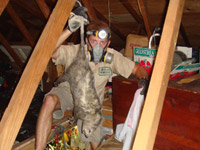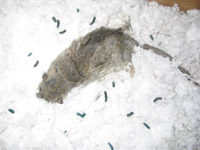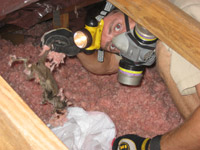It starts slowly. You get just a whisp in the air of something that doesn't smell so great. You notice it one second, then not the next. You wonder what's going on, then briefly forget it. Then you smell it again -
"What is that?" you wonder. At first it's subtle, but give it another day or two, and it's not so subtle any more! Your house smells
terrible! What is that horrifying odor? It smells like rotting meat - no, worse!
If you experience this - you suddenly end up with a horrible stench in your house, the best guess is that an animal has died somewhere inside. Most of the time, it's an
animal that was living in the attic of your house.
Emphasis on
was. Now its life is over, and it's chosen its home, your attic, as its final resting place. However, it does not rest in peace. It rests in juices and maggots and the most horrible smell you've ever
smelled. Your house smells like roadkill, and you don't want to live there. You need to get that dead animal out of the attic, and you need it done now! My eight steps below show you how.
Click the below photographs for examples of dead animal removal jobs I've done:

A dead opossum in the attic above the garage. I had to pry up boards to get it. |

A dead rat in the attic - notice the blue poisoned droppings around it. |

Removal of a dead squirrel from inside an attic. The mask definitely helps. |

A dead opossum in an attic - I had to dig it from under the insulation. |
Removal of a dead animal from an attic is simple. Just go into the attic, find it, and remove it. Easy, right? Wrong. Most of the time the animal has died in some god-forsaken part of the attic that a monkey can't reach.
They die under the insulation. They die under the ductwork. They die under the attic floorboards. They die down in that little section on the edge that is blocked by a wooden board. They rarely die out in the open, right
in the middle. In fact, much of the time they fall down a wall and die. All you know is that your house, usually one room in particular, smells horrible.
I've done several hundred dead animal removals in my career. I've seen it all, and usually the removal is not easy. When I started, it used to take me a long time - sometimes several hours - to find the dead animal. Now
I've become a true maestro at it. I'm the fastest and the best. There's no magic tool that I use, no "odor detecting machine" or device. There's no such thing. I use my experience and my nose. Here are the steps:
1) Sniff Around Inside the Home: As soon as I walk in the door, I can smell the animal, and usually know what species it is. Take a walk around inside the home. Follow your nose around, and find the area where the smell is the worst. I ask the inhabitants where they smell it the most, but I usually don't need the help. They'll usually give me inaccurate information like, "it's coming out of this duct here" - it's never coming out of that duct there. I
sniff around until I know the closest area. I sniff around the baseboards and walls in case it's fallen down a wall. If it's not down a wall, I go in the attic.
2) Enter The Attic: I go into the attic and walk toward the area of the odor. I've memorized the house layout and architecture so that I can head to the correct spot. The interesting thing is that the attic never smells
as bad as the house. Attics are well-ventilated, and oftentimes the animal is under insulation, and right on the ceiling drywall - the stink leeches through to the stagnant house, and causes a bad odor accumulation. In the attic,
the odor isn't as bad. Anyway, I walk to the approximate area, once again following my nose.
3) Sweep Back and Forth: Sometimes it is easy. Sometimes I'll go to the right area, and the dead animal will be there. However, it's usually not in plain view. In this case, I move back and forth, back and forth,
constantly sniffing, literally like a dog. If the odor is stronger behind me, I turn around. If it smells worse to the left, I go left. It can be tricky, because of airflow issues. Eventually I narrow down the area.
4) Excavate: If you've got the area down, to within a few square feet, then it's often time to excavate - dig through the insulation. Many animals tunnel under it before they die. Sniff down the walls, look under
the ducts, pry and open whatever you need to, and keep sniffing. Eventually, you'll reach the treasure.
5) Bag the Carcass: You're already wearing gloves. Put your protective mask back on (you had to remove it to sniff around). Turn a plastic garbage bag inside-out and put your hand in it, then grab the carcass and
draw it into the bag. Grab any foul body-juice-soaked insulation or any fur or residue that you can, and bag it as well. If there's maggots, I get them too.
6) Spray the Area: There's always residue, which can cause continued odor. I spray the area with a special enzyme-based biological cleaner, one that breaks down any kind of organic matter. For more information,
see my
attic decontamination page. I spray a liberal amount on the affected area.
7) Dispose of the Carcass: Depending on the trash laws in your state, you may be able to throw out the carcass. If it's a smaller animal, like a mouse, rat, or squirrel, no big deal. If it's larger, you might
want to bury or incinerate it.
8) Open the Windows: You want to let the house air out. Even though the dead animal is gone, you need to get that stinky air out, so open all the windows, turn on the fans, and let the house breathe. The odor will
go away very quickly.
If you can't get it yourself, and there's a good chance that you won't, call a pro. Many dead animal cases are very difficult. I've cut through every type of wall, ceiling, bathroom tile, concrete, you name it. Under homes,
in walls, in attics, in appliances, the dead animal could be anywhere. I'm the one who has to make the tough crawl in the attic, I'm the one who has to breathe insulation into his lungs, I'm the one who gets fleas from the
carcass on me. Plus I'm the one with all the tools - special lights, fiberoptic scopes, inspection mirrors, wall-cutting tools, my enzyme spray, etc. I don't have many skills in life, but removal of dead animal carcasses
is something I excel at.

For more dead animal information, go back to the
dead animal removal page.
If you don't live in Orlando FL, click here for the
National Directory of Wildlife Trappers.
